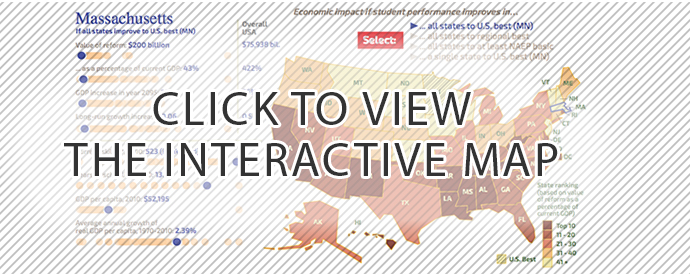Projections and additional analysis for each state are available here.
Last year, Congress passed the Every Student Succeeds Act, supplanting No Child Left Behind and placing responsibility for public school improvement squarely upon each of the 50 states. With the federal government’s role in school accountability sharply diminished, it now falls to state and local governments to take decisive action.
Large economic benefits should accrue to states that take advantage of this new flexibility. When students learn more in school, they remain in the educational system longer and become more-skilled and -effective participants in the state’s workforce. While some graduates will migrate to other parts of the country, a majority will join the labor market in their own states, thus contributing directly to their economic strength. Over the long run, each state stands to receive an extraordinary rate of return on successful efforts to improve school quality.
Even though most education policy debates have focused on school quality and student achievement, most research on the economic impact of schooling has focused narrowly on the number of years students remain in the educational system. This metric is not an adequate measure of student achievement and thus not a reliable indicator of economic impacts: it hardly matters how long one sits at a school desk if one learns little while occupying that seat. Recently, mounting evidence has suggested that measures of individual cognitive skills that incorporate dimensions of test-score performance provide much better indicators of economic outcomes—while also aligning the research with the policy deliberations. The importance of including direct measures of achievement is especially apparent when looking at differences in economic growth across states.
In this essay, we document the long-term economic impact of a state’s student-achievement levels, which in turn permits us to calculate the economic returns from school improvement. First, we show that in the 40 years between 1970 and 2010, the spread among the states in their per-capita gross domestic product (GDP) widened considerably. Next, we show that the level of student achievement is a strong predictor of the state’s growth rate in GDP per capita over that time period, even after accounting for both the standard measure of school attainment and other economic factors. Finally, we project for each state the large positive impact that improvements in student achievement would have on a state’s GDP (See Figure 1).
Any state political leader of vision would do well to make school quality a high priority.
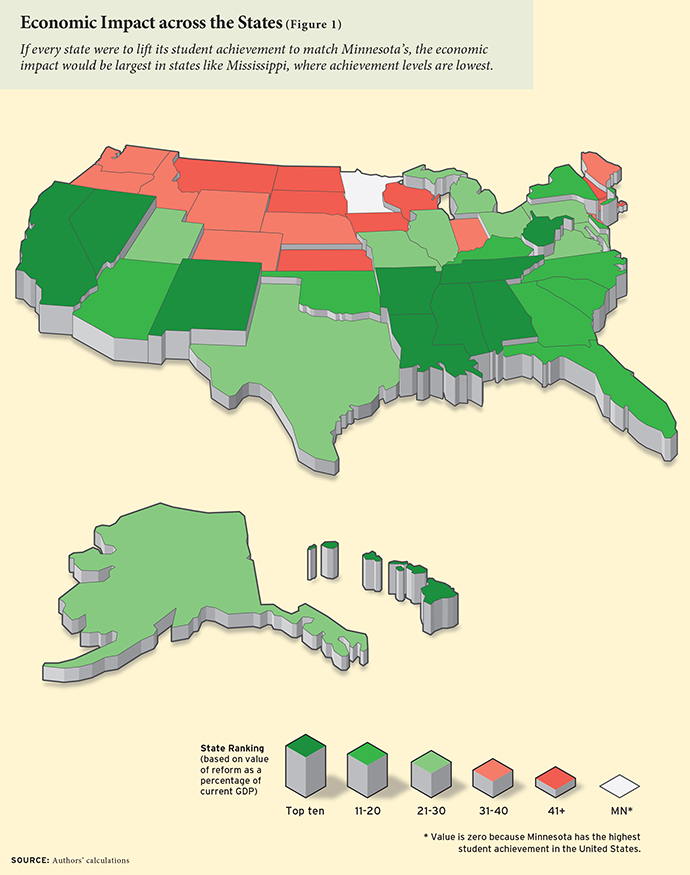
The Wealth of States
States vary sharply in the size of their per-capita GDP, that is, the total value of goods and services produced within a given year divided by the number of residents. In 2010, the wealthiest state, Delaware, enjoyed a per-capita GDP that was twice that of the poorest state, Mississippi (see Figure 2). Geographical and historical factors account for some of this variation among the states, but the discrepancies have grown over time. Importantly, the rate at which state GDPs have increased differs widely: for example, the per-capita GDP of North Dakota, the most rapidly growing state between 1970 and 2010, increased annually at a rate of 3.0 percent, while Nevada’s rate of increase was just 1.2 percent, the least of any state during this time period.
The spread among the states has remained wide and grown in absolute terms over the past several decades. In 1970 the spread between the 10th and the 40th state in the distribution was about $5,000 per capita in 2005 dollars, but by 2010 it had increased to nearly $12,000 per capita.
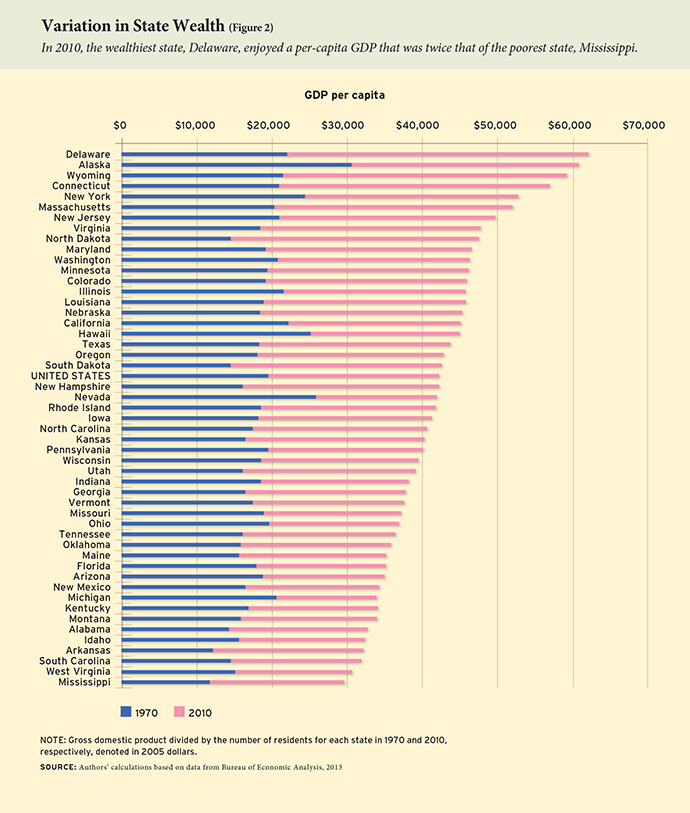
Knowledge Capital vs. School Attainment
Economists have long used the term human capital to refer to the skills individuals possess that have economic value and that pay off in the labor market. But their near-ubiquitous reliance on school attainment to measure individual skill differences has made years of schooling virtually synonymous with human capital. That measure of human capital, however, implicitly assumes that each additional year of schooling translates into a comparable increment in the stock of relevant skills, totally ignoring any variations in the quality of the student’s home, community, school, teachers, and other factors.
Here, we combine the quantity of schooling with a measure of cognitive skills in order to develop a more complete understanding of differences in individuals’ labor-market skills. In the aggregate, we call this broader measure the knowledge capital of states in order to distinguish it sharply from school attainment, or conventionally measured human capital. We rely upon math test scores from the National Assessment of Educational Progress (NAEP) and various international tests to provide data on the cognitive skills of each state’s adult workers.
Using these estimates, we then consider the impact of knowledge capital on the growth in a state’s GDP. In that way, we can estimate the impact of knowledge capital on a state’s wealth and can explain, at least in part, the divergent growth rates in GDP per capita among the states between 1970 and 2010.
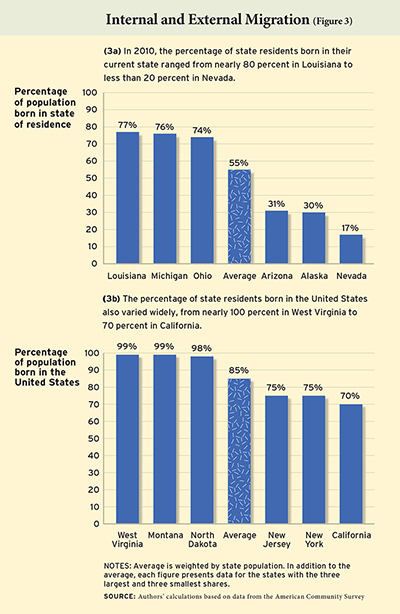 Developing state-by-state measures of knowledge capital requires some effort. If we are to obtain an unbiased estimate of the achievement levels of a state’s adult workers, we cannot simply calculate the test scores of students currently attending the state’s schools. Many workers have migrated from a different state, and still others have immigrated to the United States from abroad; both of these groups will tend to differ in their cognitive skills from those who remain in a state after finishing their education. The degree to which state workforces consist of migrants from other parts of the United States is illustrated in Figure 3a, and the impact of foreign immigration is shown in Figure 3b. In 2010, less than 60 percent of adults living in the median state were also born in that state. The range across states varies from less than 20 percent (Nevada) to almost 80 percent (Louisiana). The share of adults not born in the United States in 2010 ranges from just 1 percent (West Virginia) to almost 30 percent (California).
Developing state-by-state measures of knowledge capital requires some effort. If we are to obtain an unbiased estimate of the achievement levels of a state’s adult workers, we cannot simply calculate the test scores of students currently attending the state’s schools. Many workers have migrated from a different state, and still others have immigrated to the United States from abroad; both of these groups will tend to differ in their cognitive skills from those who remain in a state after finishing their education. The degree to which state workforces consist of migrants from other parts of the United States is illustrated in Figure 3a, and the impact of foreign immigration is shown in Figure 3b. In 2010, less than 60 percent of adults living in the median state were also born in that state. The range across states varies from less than 20 percent (Nevada) to almost 80 percent (Louisiana). The share of adults not born in the United States in 2010 ranges from just 1 percent (West Virginia) to almost 30 percent (California).
To obtain our estimate of the student achievement component of the knowledge capital of a state at any point in time, we use census data to trace workers back to the place in which they were born. With that information, we can obtain a good estimate of the achievement of migrants from various states, because, on average, 86 percent of children age 14 or younger attend school in their state of birth. To estimate the achievement of workers born in the United States, we use mathematics test scores on the NAEP for 8th graders by birth state between 1990 and 2011. For workers born and educated outside of the United States, we use mathematics scores from the Program for International Student Assessment (PISA) and the Trends in International Mathematics and Science Study (TIMSS) conducted between 1995 and 2011.
We know, however, that both state migration patterns and the skills of interstate migrants are likely to differ depending on people’s educational background, so we estimate NAEP scores separately for workers with different levels of educational attainment. For example, we assume that we can assign to a college-educated individual born in Massachusetts (but possibly living elsewhere) the average test score of students with college-educated parents in Massachusetts. The achievement levels of international immigrants educated abroad are assumed to be the same as those of students performing at the 90th percentile of the distribution in their home country. We make this assumption because studies have shown that a country’s emigrants to the United States tend to be among its most talented people. (In a separate analysis, we modify this assumption to account for the less-selective nature of Mexican immigration into the United States; these results differ little from the ones reported here.)
Knowledge Capital and Economic Growth
To estimate how knowledge capital relates to the growth in a state’s GDP, we correlate the rate of GDP growth from 1970 to 2010 with our measures of the average knowledge capital of the state’s workers (based on the state’s workforce in 1970, the beginning of our growth period). Simultaneously, we adjust for the influence of three other factors that are usually hypothesized to be related to growth rates: the initial (1970) values of the level of GDP per capita, of physical capital per worker, and of the average number of years of schooling.
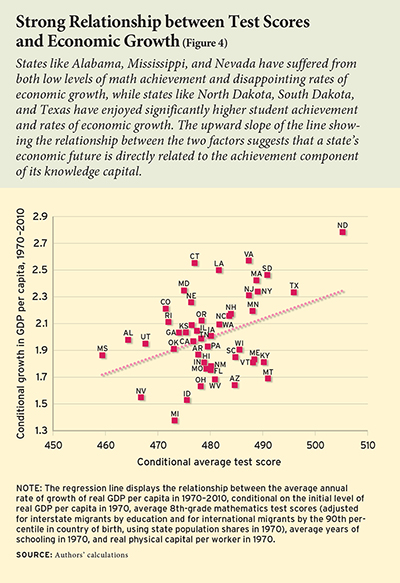 Figure 4 reveals a strong relationship between the achievement component of the knowledge capital of a state’s adult workers and economic growth in that state. The cluster of states in the lower left-hand corner of the graph—Alabama, Mississippi, Utah, Nevada—have suffered from both low math achievement levels on the part of their workforces and disappointing rates of economic growth. Those in the upper right-hand corner—North Dakota, South Dakota, Minnesota, Texas, Massachusetts, and Virginia—have enjoyed both significantly higher levels of math achievement and higher rates of economic growth.
Figure 4 reveals a strong relationship between the achievement component of the knowledge capital of a state’s adult workers and economic growth in that state. The cluster of states in the lower left-hand corner of the graph—Alabama, Mississippi, Utah, Nevada—have suffered from both low math achievement levels on the part of their workforces and disappointing rates of economic growth. Those in the upper right-hand corner—North Dakota, South Dakota, Minnesota, Texas, Massachusetts, and Virginia—have enjoyed both significantly higher levels of math achievement and higher rates of economic growth.
The connection between the two variables—achievement levels and economic growth—is not perfect, of course. Given the levels of achievement of workers in Kentucky, Maine, Vermont, and Montana, these states should have enjoyed higher rates of economic growth. Conversely, the economies of Connecticut, Maryland, Virginia, and Louisiana have performed better than expected, given achievement levels. But, overall, our results suggest that achievement levels that are 1 standard deviation higher—for example, having the average worker in a state achieve at the 69th percentile rather than at the 31st percentile of the overall distribution of cognitive skills—yield an average annual growth rate that is 1.4 percentage points higher.
Some may question whether this correlation actually reflects a causal relationship. One could argue that students simply learn more when their state is performing well economically, perhaps because growth generates additional resources that can be spent on education or because students are more motivated to learn when prosperity is close at hand. We are not persuaded by these arguments, in part because of the very weak correlation between increased spending on schools and higher levels of student achievement. Furthermore, the cross-state results are virtually identical to previous results from international research, and extensive analysis of the cross-country evidence has shown that a causal interpretation of the relationships is credible.
To test the credibility of our results further, we also undertook a standard accounting exercise used by economists to determine how much of the total variation in economic performance among states at any point in time can be attributed to differences in a specific factor. In particular, we use existing research about how much a high level of achievement boosts the earnings of an individual worker, combined with our new measures of the average achievement levels of workers in each state, to gauge the contribution of differences in achievement to differences in income levels across states. And we perform a parallel analysis to shed light on the role played by differences in average years of schooling.
The results of this exercise again suggest the importance of knowledge capital for state economic prosperity. We find that differences in achievement and attainment account for 20 to 35 percent of the current variation in per-capita GDP among states, with average years of schooling and achievement levels making roughly even contributions. In a sense, this estimate is surprisingly large, because both labor and capital are free to move across states—and thus tend to equalize rewards to workers with different skills. But our results are quite consistent with those obtained from similar analyses of the role of student-achievement levels in explaining differences in economic performance across countries (see “Education and Economic Growth,” research, Spring 2008).
Gains from Educational Improvement
The fact that the achievement level of a state’s workers is a key driver of its economic performance suggests that the gains from improved school quality could be substantial. Just how large would they be? We consider a range of improvements in student achievement and estimate the economic impact for each of the 50 states and for the nation as a whole. The various scenarios include:
1) Bringing every state up to the best state in the United States (Minnesota)
2) Bringing every state up to the best state in its region
3) Bringing all students in each state up to the NAEP basic achievement level
4) Bringing each state up to the best state, but assuming others do not make any gains at all, thereby isolating the direct impact of a state’s efforts.
The calculations of the economic impact are straightforward. First, we estimate the expected growth of a state’s economy if the current skill level of workers were to remain unchanged. Then we compare this growth path to the one that would be achieved with better schools (and subsequently improved skill levels). The gains in GDP are discounted (at 3 percent per year), so that near-term gains are given more weight than gains in the more distant future. The resulting present values of income gains can be compared directly to current state GDP levels.
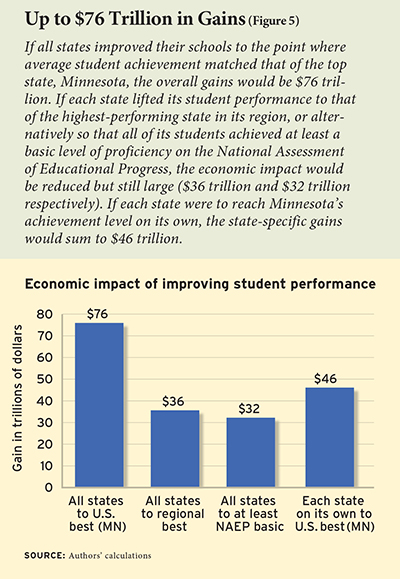 Our projections account for the fact that improvement in worker skills is not instantaneous. First, we assume that education reforms take 10 years to be fully effective, with student skills improving steadily over that time. Second, the labor force improves only as new, more-skilled students replace retiring less-skilled workers. We assume that 2.5 percent of the labor force retires each year and that these workers are replaced by better-educated ones, implying that the labor force does not fully reach its ultimate new skill level for 50 years
(10 years of reform followed by 40 years of retirements).
Our projections account for the fact that improvement in worker skills is not instantaneous. First, we assume that education reforms take 10 years to be fully effective, with student skills improving steadily over that time. Second, the labor force improves only as new, more-skilled students replace retiring less-skilled workers. We assume that 2.5 percent of the labor force retires each year and that these workers are replaced by better-educated ones, implying that the labor force does not fully reach its ultimate new skill level for 50 years
(10 years of reform followed by 40 years of retirements).
Figure 5 displays the economic gains from each reform scenario for the United States as a whole over the expected lifetime of a person born today (80 years), expressed in trillions of 2015 dollars. If all states improved their schools to the point where average student achievement matched that of the top state, Minnesota, the overall gains would be $76 trillion, or more than four times the current GDP of the United States. An alternative way to view this is that the nation would, on average, see a 9 percent higher level of GDP across the next 80 years. Such an increase is easily large enough to allow even the most cash-strapped state to meet current demands for public services while maintaining a balanced budget. In 2095, the GDP would be more than 36 percent larger than would be seen without school-quality improvements.
The projected economic impact of the school-improvement reforms varies considerably across the country, according to differences in the current economic position and knowledge-capital stock of each state. For example, Figure 6 shows the gains in economic outcomes that result when all states are brought up to the skill level of top-performing Minnesota (Scenario 1). This improvement means the least in North Dakota and Massachusetts, whose students are currently very close to that level, and the most in Alabama and Mississippi, where achievement levels are lowest. If California’s students could perform at the same level as Minnesota’s, the benefits to the state would exceed $16 trillion, assuming other states reached the Minnesota level. Even in North Dakota and Massachusetts, the current value of gains over the next 80 years would amount to 70 percent of current state GDP.
We find somewhat smaller gains from having each state meet the achievement level of the best state in its region (Scenario 2). This growth is necessarily less than that of the first scenario, because the achievement levels of the regional leaders vary widely. Nonetheless, the aggregate gains from Scenario 2 still have a present value of more than $35 trillion, almost twice the nation’s current GDP.
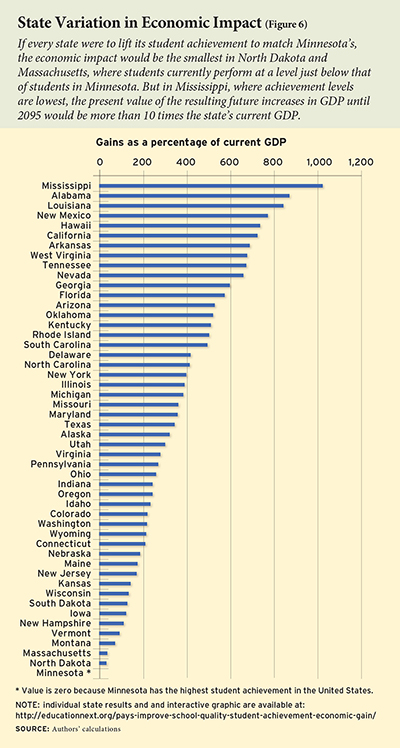 Scenario 3 essentially projects the results of realizing the achievement goals of NCLB—getting all students to a basic level of academic proficiency—but by the year 2025. The gains from all states getting students to the NAEP basic achievement level are roughly twice current GDP, or about the same as for Scenario 2.
Scenario 3 essentially projects the results of realizing the achievement goals of NCLB—getting all students to a basic level of academic proficiency—but by the year 2025. The gains from all states getting students to the NAEP basic achievement level are roughly twice current GDP, or about the same as for Scenario 2.
The results for Scenario 4 represent what happens if one state acts on its own to improve school quality while all other states do not. This is an important perspective to consider, since no state that commits to a path of reform can necessarily expect others to join in, even though that would be desirable. In any given state, some of the students who profit from the improved quality of its schools will move out of the state. While the better-educated out-migrants will boost the economy of their new states, their native states will experience a brain drain.
So, what if a single state improves but others do not? Will it still benefit? Figure 5 shows that the single-state improvement strategy (summed up across all states) yields a gain of $46 trillion. When we compare this present value to that of Scenario 1, where all states move to perform at the level of the best state, we see that joint action yields gains that are 65 percent larger than the gains that would accrue to each state acting on its own. That is, aggregate rewards are smaller if any state acts without comparable efforts by others; at the same time, even the gains of acting independently are substantial.
Summing Up
Clearly, the United States stands to reap enormous economic gains from improving its schools. The goals for boosting student achievement considered in the separate scenarios of this paper are within the feasible range for most states. The largest gains would come from a coordinated improvement in performance, since states are all linked by flows of people over time. But even if states act individually, they can promote a better economic future for their residents through education reform. The gains projected here not only make the residents of each state better-off but also show how states’ fiscal problems can be tackled when knowledge capital increases.
A key feature of this analysis is that we built in realistic patterns of movements of the labor force across U.S. states and of the dynamics of school improvement. Simply put, raising the achievement of today’s students has no immediate impact on a state’s economy, because these students are not yet in the labor force. But as the skills of today’s students improve, the skills of tomorrow’s workers advance as well. Realizing these gains does require a sustained commitment on the part of a state’s political leaders. But such commitment to better schools has already given rise to dramatic gains in the United States (for instance, in Massachusetts) and abroad (as in South Korea). If we are to achieve prolonged economic growth in our nation, we have little choice but to strengthen the skills of our people.
Eric A. Hanushek is senior fellow at the Hoover Institution at Stanford University and research associate at the National Bureau of Economic Research. Jens Ruhose is an economist at Leibniz University Hannover. Ludger Woessmann is professor of economics at the University of Munich and director of the Ifo Center for the Economics of Education.
This article appeared in the Summer 2016 issue of Education Next. Suggested citation format:
Hanushek, E.A., Ruhose, J., and Woessmann, L. (2016). It Pays to Improve School Quality: States that boost student achievement could reap large economic gains. Education Next, 16(3), 52-60.


